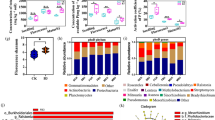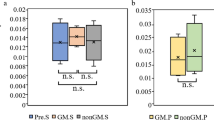Abstract
Background and aims
Green manuring can suppress crop diseases and change soil microbial communities, but the functional significances of changes in soil microbial communities are unclear.
Methods
Effects of Indian mustard (Brassica juncea), wild rocket (Diplotaxis tenuifolia) and wheat (Triticum aestivum) green manures on cucumber (Cucumis sativus L.) Fusarium wilt disease caused by Fusarium oxysporum f.sp. cucumerinum (FOC) were evaluated. Cucumber rhizosphere microbial communities were analyzed by real-time PCR and high-throughput amplicon sequencing. Furthermore, feedback effects of rhizosphere biota on cucumber resistance to FOC were assessed.
Results
All green manures promoted cucumber growth and changed rhizosphere bacterial community composition. Indian mustard and wild rocket green manures decreased Fusarium wilt disease severity and rhizosphere FOC abundance, increased bacterial diversity and abundance of potential plant-beneficial microorganisms. Rhizosphere biota from cucumber cultivated with Indian mustard and wild rocket (but not with wheat) green manures suppressed Fusarium wilt disease and enhanced expression of defense-related genes in cucumber seedling roots. Pseudomonas spp. strains isolated from cucumber rhizosphere cultivated with Indian mustard and wild rocket green manures suppressed cucumber Fusarium wilt disease.
Conclusions
Changes in cucumber rhizosphere microbial communities induced by Indian mustard and wild rocket suppressed Fusarium wilt disease by priming for defense in plants.







Similar content being viewed by others
References
Alizadeh H, Behboudi K, Ahmadzadeh M, Javan-Nikkhah M, Zamioudis C, Pieterse CMJ, Bakker PAHM (2013) Induced systemic resistance in cucumber and Arabidopsis thaliana by the combination of Trichoderma harzianum Tr6 and Pseudomonas sp. Ps14. Biol Control 65:14–23
Almario J, Moenne-Loccoz Y, Muller D (2013) Monitoring of the relation between 2,4-diacetylphloroglucinol-producing Pseudomonas and Thielaviopsis basicola populations by real-time PCR in tobacco black root-rot suppressive and conducive soils. Soil Biol Biochem 57:144–155
Bennett AJ, Bending GD, Chandler D, Hilton S, Mills P (2012) Meeting the demand for crop production: the challenge of yield decline in crops grown in short rotations. Biol Rev 87:52–71
Berendsen RL, Vismans G, Yu K, Song Y, de Jonge R, Burgman WP, Burmolle M, Herschend J, Bakker P, Pieterse CMJ (2018) Disease-induced assemblage of a plant-beneficial bacterial consortium. ISME J 12:1496–1507
Bever JD, Platt TG, Morton ER (2012) Microbial population and community dynamics on plant roots and their feedbacks on plant communities. Annu Rev Microbiol 66:265–283
Bonanomi G, Antignani V, Pane C, Scala F (2007) Suppression of soilborne fungal diseases with organic amendments. J Plant Pathol 89:311–324
Brinkman EP, Van der Putten WH, Bakker EJ, Verhoeven KJF (2010) Plant-soil feedback: experimental approaches, statistical analyses and ecological interpretations. J Ecol 98:1063–1073
Caporaso JG, Kuczynski J, Stombaugh J, Bittinger K, Bushman FD, Costello EK, Fierer N, Peña AG, Goodrich JK, Gordon JI, Huttley GA, Kelley ST, Knights D, Koenig JE, Ley RE, Lozupone CA, McDonald D, Muegge BD, Pirrung M, Reeder J, Sevinsky JR, Turnbaugh PJ, Walters WA, Widmann J, Yatsunenko T, Zaneveld J, Knight R (2010) QIIME allows analysis of high-throughput community sequencing data. Nat Methods 7:335–336
Chakraborty S, Newton AC (2011) Climate change, plant diseases and food security: an overview. Plant Pathol 60(1):2–14
Edgar RC (2013) UPARSE: highly accurate OTU sequences from microbial amplicon reads. Nat Methods 10:996–998
Elfstrand S, Båth B, Mårtensson A (2007) Influence of various forms of green manure amendment on soil microbial community composition, enzyme activity and nutrient levels in leek. Appl Soil Ecol 36:70–82
Garbeva P, van Veen JA, van Elsas JD (2004) Assessment of the diversity, and antagonism towards Rhizoctonia solani AG3, of Pseudomonas species in soil from different agricultural regimes. FEMS Microbiol Ecol 47:51–64
Gordon S, Weber R (1951) Colorimetric estimation of indoleacetic acid. Plant Physiol 26:192–195
Gould WD, Hagedorn C, Bardinelli TR, Zablotowicz RM (1985) New selective media for enumeration and recovery of fluorescent Pseudomonads from various habitats. Appl Environ Microbiol 49:28–32
Hanschen FS, Yim B, Winkelmann T, Smalla K, Schreiner M (2015) Degradation of biofumigant isothiocyanates and allyl glucosinolate in soil and their effects on the microbial community composition. PLoS One 10:e0132931
Inderbitzin P, Ward J, Barbella A, Solares N, Izyumin D, Burman P, Chellemi DO, Subbarao KV (2018) Soil microbiomes associated with Verticillium wilt-suppressive broccoli and chitin amendments are enriched with potential biocontrol agents. Phytopathology 108:31–43
Jia HT, Chen SC, Yang SY, Shen YH, Qiao PL, Wu FZ, Zhou XG (2018) Effects of vanillin on cucumber rhizosphere bacterial community. Allelopath J 44:191–200
** X, Wang J, Li D, Wu F, Zhou X (2019) Rotations with Indian mustard and wild rocket suppressed cucumber Fusarium wilt disease and changed rhizosphere bacterial communities. Microorganisms 7:57
Jogaiah S, Abdelrahman M, Tran LSP, Ito SI (2018) Different mechanisms of Trichoderma virens-mediated resistance in tomato against Fusarium wilt involve the jasmonic and salicylic acid pathways. Mol Plant Pathol 19:870–882
Jousset A, Becker J, Chatterjee S, Karlovsky P, Scheu S, Eisenhauer N (2014) Biodiversity and species identity shape the antifungal activity of bacterial communities. Ecology 95:1184–1190
King EO, Ward MK, Raney DE (1954) Two simple media for the demonstration of pyocyanin and fluorescin. J Lab Clin Med 44:301–307
Klein E, Ofek M, Katan J, Minz D, Gamliel A (2013) Soil suppressiveness to Fusarium disease: shifts in root microbiome associated with reduction of pathogen root colonization. Phytopathology 103:23–33
Klein E, Katan J, Gamliel A (2016) Soil suppressiveness by organic amendment to Fusarium disease in cucumber: effect on pathogen and host. Phytoparasitica 44:239–249
Larkin RP, Griffin TS (2007) Control of soilborne potato diseases using Brassica green manures. Crop Prot 26:1067–1077
Latz E, Eisenhauer N, Scheu S, Jousset A (2015) Plant identity drives the expression of biocontrol factors in a rhizosphere bacterium across a plant diversity gradient. Funct Ecol 29:1225–1234
Lin L, Li Z, Hu C, Zhang X, Chang S, Yang L, Li Y, An Q (2012) Plant growth-promoting nitrogen-fixing enterobacteria are in association with sugarcane plants growing in Guangxi, China. Microbes Environ 27:391–398
Liu L, Kloepper JW, Tuzun S (1995) Induction of systemic resistance in cucumber against Fusarium wilt by plant growth-promoting rhizobacteria. Phytopathology 85:695–698
Livak KJ, Schmittgen TD (2001) Analysis of relative gene expression data using real-time quantitative PCR and the 2− ΔΔCT method. Methods 25:402–408
Loreau M, Hector A (2001) Partitioning selection and complementarity in biodiversity experiments. Nature 412:72–76
Lugtenberg B, Kamilova F (2009) Plant-growth-promoting rhizobacteria. Annu Rev Microbiol 63:541–556
Lv H, Cao H, Nawaz MA, Sohail H, Huang Y, Cheng F, Kong Q, Bie Z (2018) Wheat intercrop** enhances the resistance of watermelon to fusarium wilt. Front Plant Sci 9:696
Ma H, Pineda A, Van der Wurff AWG, Bezemer TM (2018) Carry-over effects of soil inoculation on plant growth and health under sequential exposure to soil-borne diseases. Plant Soil 433:257–270
Magoc T, Salzberg SL (2011) FLASH: fast length adjustment of short reads to improve genome assemblies. Bioinformatics 27:2957–2963
Marschner P, Rumberger A (2004) Rapid changes in the rhizosphere bacterial community structure during re-colonization of sterilized soil. Biol Fertil Soils 40:1–6
Mendes R, Garbeva P, Raaijmakers JM (2013) The rhizosphere microbiome: significance of plant beneficial, plant pathogenic, and human pathogenic microorganisms. FEMS Microbiol Rev 37:634–633
Meng L, Yao X, Yang Z, Zhang R, Zhang C, Wang X, Xu N, Li S, Liu T, Zheng C (2018) Changes in soil microbial diversity and control of Fusarium oxysporum in continuous crop** cucumber greenhouses following biofumigation. Emir J Food Agric 30:644–653
Michielse CB, Rep M (2009) Pathogen profile update: Fusarium oxysporum. Mol Plant Pathol 10:311–324
Motisi N, Montfort F, Doré T, Romillac N, Lucas P (2009) Duration of control of two soilborne pathogens following incorporation of above- and below-ground residues of Brassica juncea into soil. Plant Pathol 58:470–478
Mowlick S, Yasukawa H, Inoue T, Takehara T, Kaku N, Ueki K, Ueki A (2013) Suppression of spinach wilt disease by biological soil disinfestation incorporated with Brassica juncea plants in association with changes in soil bacterial communities. Crop Prot 54:185–193
Muyzer G, de Waal EC, Uitterlinden AG (1993) Profiling of complex microbial populations by denaturing gradient gel electrophoresis analysis of polymerase chain reaction-amplified genes encoding for 16S rRNA. Appl Environ Microbiol 59:695–700
Naureen Z, Rehman NU, Hussain H, Hussain J, Gilani SA, Al Housni SK, Mabood F, Khan AL, Farooq S, Abbas G, Harrasi AA (2017) Exploring the potentials of Lysinibacillus sphaericus ZA9 for plant growth promotion and biocontrol activities against phytopathogenic fungi. Front Microbiol 8:1477
Ongena M, Jourdan E, Adam A, Paquot M, Brans A, Joris B, Arpigny JL, Thonart P (2007) Surfactin and fengycin lipopeptides of Bacillus subtilis as elicitors of induced systemic resistance in plants. Environ Microbiol 9:1084–1090
Perez C, Dill-Macky R, Kinkel LL (2008) Management of soil microbial communities to enhance populations of Fusarium graminearum-antagonists in soil. Plant Soil 302:53–69
Pérez-Miranda S, Cabirol N, George-Téllez R, Zamudio-Rivera LS, Fernández FJ (2007) O-CAS, a fast and universal method for siderophore detection. J Microbiol Methods 70:127–131
Philippot L, Raaijmakers JM, Lemanceau P, van der Putten WH (2013) Going back to the roots: the microbial ecology of the rhizosphere. Nat Rev Microbiol 11:789–799
Pieterse CMJ, Zamioudis C, Berendsen RL, Weller DM, Wees SCMV, Bakker PAHM (2014) Induced systemic resistance by beneficial microbes. Annu Rev Phytopathol 52:347–375
Scarlett K, Tesoriero L, Daniel R, Guest D (2013) Detection and quantification of Fusarium oxysporum f. sp. cucumerinum in environmental samples using a specific quantitative PCR assay. Eur J Plant Pathol 137:315–324
Schöler A, Jacquiod S, Vestergaard G, Schulz S, Schloter M (2017) Analysis of soil microbial communities based on amplicon sequencing of marker genes. Biol Fertil Soils 53:485–489
Smolinska U (2000) Survival of Sclerotium cepivorum sclerotia and Fusarium oxysporum chlamydospores in soil amended with cruciferous residues. J Phytopathol 148:343–349
Tilman D, Balzer C, Hill J, Befort BL (2011) Global food demand and the sustainable intensification of agriculture. Proc Natl Acad Sci U S A 108:20260–20264
Wan H, Zhao Z, Qian C, Sui Y, Malik AA, Chen J (2010) Selection of appropriate reference genes for gene expression studies by quantitative real-time polymerase chain reaction in cucumber. Anal Biochem 399:257–261
Wang Q, Garrity GM, Tiedje JM, Cole JR (2007) Naïve Bayesian classifier for rapid assignment of rRNA sequences into the new bacterial taxonomy. Appl Environ Microbiol 73:5261–5267
Wang Y, Wu F, Zhou X (2010) Allelopathic effects of wheat, soybean and oat residues on cucumber and Fusarium oxysporum f.sp cucumerinum Owen. Allelopath J 25:107–114
Wang Z, Zhang J, Wu F, Zhou X (2018) Changes in rhizosphere microbial communities in potted cucumber seedlings treated with syringic acid. PLoS One 13:e0200007
Wiggins B, Kinkel L (2005) Green manures and crop sequences influence potato diseases and pathogen inhibitory activity of indigenous Streptomycetes. Phytopathology 95:178–185
Xu W, Liu D, Wu F, Liu S (2015) Root exudates of wheat are involved in suppression of Fusarium wilt in watermelon in watermelon-wheat companion crop**. Eur J Plant Pathol 141:209–216
Zhou X, Yu G, Wu F (2011) Effects of intercrop** cucumber with onion or garlic on soil enzyme activities, microbial communities and cucumber yield. Eur J Soil Biol 47:279–287
Zhou X, Liu J, Wu F (2017) Soil microbial communities in cucumber monoculture and rotation systems and their feedback effects on cucumber seedling growth. Plant Soil 415:507–520
Zhou X, Shen Y, Fu X, Wu F (2018a) Application of sodium silicate enhances cucumber resistance to Fusarium wilt and alters soil microbial communities. Front Plant Sci 9:624
Zhou X, Zhang J, Pan D, Ge X, ** X, Chen S, Wu F (2018b) p-Coumaric can alter the composition of cucumber rhizosphere microbial communities and induce negative plant-microbial interactions. Biol Fertil Soils 54:363–372
Acknowledgements
This work was supported by the Natural Science Foundation of Heilongjiang Province (YQ2019C009) and National Natural Science Foundation of China (31772361).
Author information
Authors and Affiliations
Corresponding author
Additional information
Responsible Editor: Peter J. Gregory.
Publisher’s note
Springer Nature remains neutral with regard to jurisdictional claims in published maps and institutional affiliations.
Electronic supplementary material
ESM 1
(DOC 3939 kb)
Rights and permissions
About this article
Cite this article
**, X., Zhang, J., Shi, Y. et al. Green manures of Indian mustard and wild rocket enhance cucumber resistance to Fusarium wilt through modulating rhizosphere bacterial community composition. Plant Soil 441, 283–300 (2019). https://doi.org/10.1007/s11104-019-04118-6
Received:
Accepted:
Published:
Issue Date:
DOI: https://doi.org/10.1007/s11104-019-04118-6




